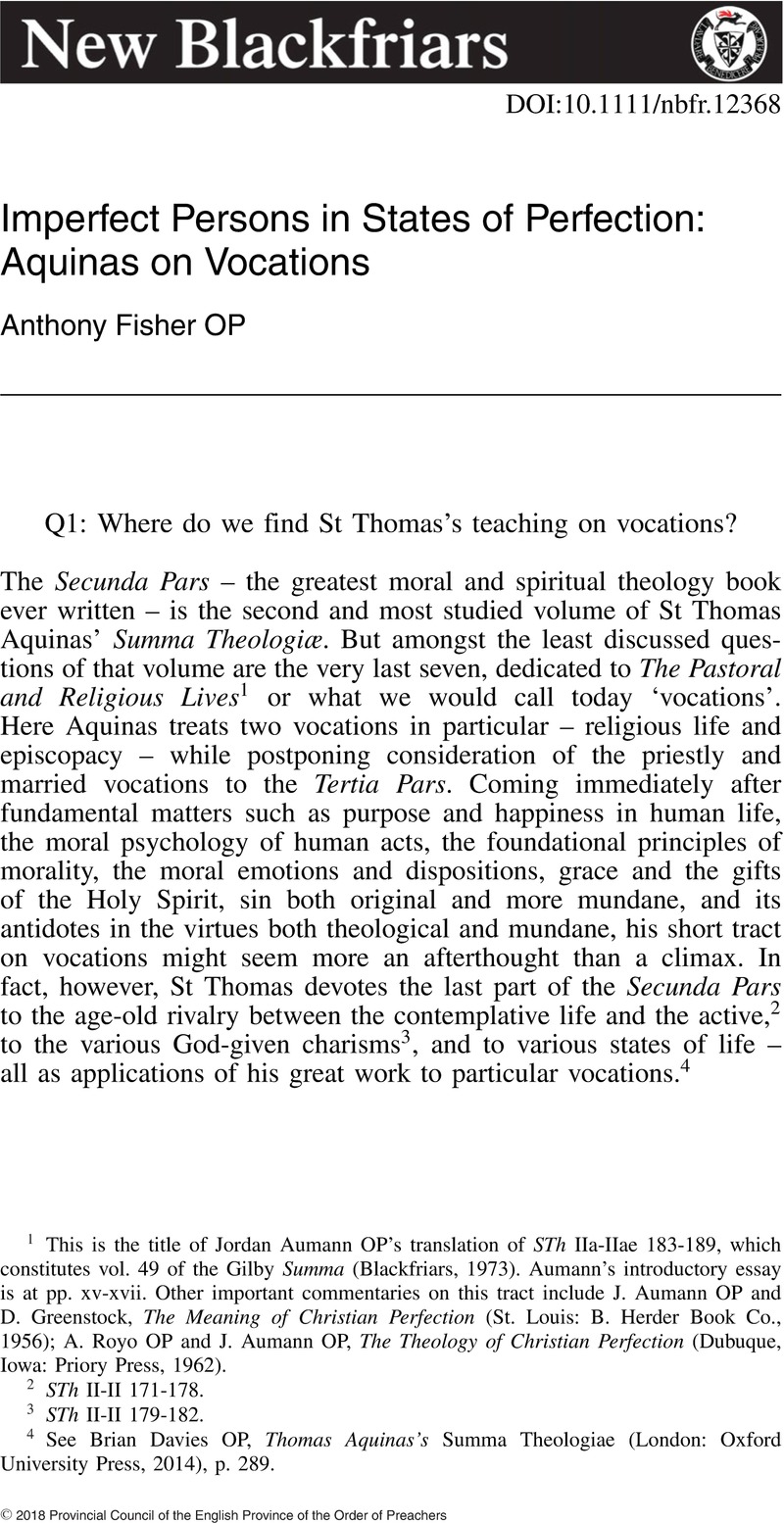No CrossRef data available.
Published online by Cambridge University Press: 01 January 2024

1 This is the title of Jordan Aumann OP's translation of STh IIa‐IIae 183‐189, which constitutes vol. 49 of the Gilby Summa (Blackfriars, 1973). Aumann's introductory essay is at pp. xv‐xvii. Other important commentaries on this tract include Aumann, J. OP and Greenstock, D., The Meaning of Christian Perfection (St. Louis: B. Herder Book Co., 1956)Google Scholar; Royo, A. OP and Aumann, J. OP, The Theology of Christian Perfection (Dubuque, Iowa: Priory Press, 1962)Google Scholar.
2 STh II‐II 171‐178.
3 STh II‐II 179‐182.
4 See Davies, Brian OP, Thomas Aquinas's Summa Theologiae (London: Oxford University Press, 2014), p. 289Google Scholar.
5 Pope Pius XI, Studiorum Ducem: Encyclical on St Thomas Aquinas (1923), 21.
6 Vatican Council II, Lumen Gentium 9‐13 and esp ch 5.
7 Weddell, Sherry, Forming Intentional Disciples: The Path to Knowing and Following Jesus (Huntington, Indiana: Our Sunday Visitor Publishing Division, 2012)Google Scholar; Pope Francis, Evangelii Gaudium: Apostolic Exhortation on the Proclamation of the Gospel in Today's World (2013).
8 Mt 25:14‐30; Lk 12:42‐48; cf. 1Tim 6:20; 2Tim 1:12‐14.
9 STh II‐II 186.10.
10 STh II‐II 185. And 185.41.
11 Commentary on the Epistle to the Hebrews ch 13, lect 3.
12 See Kerr, Fergus, After Aquinas: Versions of Thomism, (Malden: Blackwell, 2002), pp. 4‐6CrossRefGoogle Scholar.
13 Torrell, Jean‐Pierre OP, St. Thomas Aquinas, Vol. 1: The Person and His Work, revised edition, trans. By Royal, Robert, (Washington: Catholic University Press of America, 1996, first published 1993), pp. 76‐84Google Scholar.
14 Ibid., see also D. Chardonnens, Chartularium Universitatis Parisiensis, no. 240, pp. 267‐270; no. 244, pp. 276‐277.
15 Jean‐Pierre Torrell OP, St. Thomas Aquinas, Vol. 1: The Person and His Work, p. 80.
16 Fergus Kerr, After Aquinas, p. 6.
17 Jean‐Pierre Torrell OP, St. Thomas Aquinas, Vol. 1: The Person and His Work, p. 290.
18 Lk 10:38‐42.
19 STh II‐II 179‐182, 18.6.
20 Murray, Paul OP, The New Wine of Dominican Spirituality: A Drink Called Happiness (London: Burns & Oates, 2006)Google Scholar.
21 St Thomas includes questions directed very much to this controversy, such as: Whether the state of religious is more perfect than the state of prelates? Whether parish priests and archdeacons are more perfect than religious? Whether it is lawful for religious to live on alms? Whether is lawful for religious to beg? Whether it is lawful for religious to wear coarser clothes than others? See Aumann's note (a) in Summa, vol. 47, p.49; Torrell, Jean‐Pierre OP, Saint Thomas Aquinas, vol. 2: Spiritual Master (Washington: Catholic University of America Press, 2003), pp. 356‐7Google Scholar; Labourdette, M.‐M., “L'idéal dominicain,” Revue thomiste 92 (1992), pp. 344‐354Google Scholar; Motte, A., “La définition de la vie religieuese selon saint Thomas d'Aquin,” Revue thomiste 87 (1987), pp. 442‐53Google Scholar. Torrell nonetheless notes St Thomas’ very positive view of ‘the secular’ at pp. 245‐51, 307‐8 etc.
22 STh II‐II 188.4 and 188.6.
23 STh II‐II 184.
24 STh I 6.3 and 73.1, on which see Aumann, ‘Introduction’, p. xvii.
25 STh II‐II 186.2.
26 STh II‐II 184.1; Aumann, ‘Introduction’, p. xvii.
27 STh II‐II 183.4.
28 STh II‐II 184.4 and 184.5.
29 STh II‐II 184.5.
30 STh Supp 40.5.
31 Vatican Council II, Lumen Gentium 21.
32 Jn 10:15; STh II‐II 184.4 & 5.
33 STh II‐II 185.4. Perhaps excusing his friend and mentor Albert for resigning his see after only two years, Thomas notes at 185.5 if the salvation of his subjects can be sufficiently provided for in the absence of the Shepherd, then it is lawful for the Shepherd to leave his flock, whether it be for some benefit to the Church or because of personal danger”.
34 STh II‐II 184‐186.
35 STh II‐II 189.4 and 189.8.
36 STh I 4; II‐II 184.1 and 184.2. Referring as he does repeatedly in this section to Pseudo‐Dionysius’ Ecclesiastical Hierarchy, there is more than a hint of the Neoplatonic notion of participation by degrees in the divine perfections.
37 STh II‐II 184.5.
38 STh II‐II 184.4. See Pope, Stephen, “Overview of the ethics of Aquinas,” in Pope, (ed), The Ethics of Aquinas (Washington: Georgetown University Press, 2002), pp. 30‐56, at p. 48Google Scholar.
39 STh II‐II 184.4 citing Mt 21:28ff.
40 Sirilla, Michael, St Thomas Aquinas’ Theology of the Episcopacy in His Commentaries on the Pastoral Epistles (Doctoral thesis, Catholic University of America, 2008), p. 98 and sources thereinGoogle Scholar.
41 Vatican Council II, Lumen Gentium 44.
42 Sighart, Joachim, Albert the Great, of the Order of Preachers: His Life and Scholastic Labours, trans. By Dikon, T. A. (London: Washbouren, 1876), pp. 208‐210Google Scholar.
43 STh II‐II 185.2.
44 STh II‐II 185.
45 CIC 705.
46 The obligation of religious bishops to wear their religious habit was reaffirmed by the Council of Trent (Session XIV, 6) and subsequent legislation (e.g. Pope Benedict XIII, Custodes super (1725)). While Pope Paul VI abolished specific religious episcopal habits, the contemporary Ceremonial of Bishops n. 1204 provides that bishops from religious orders may wear the habit of their institute.
47 STh II‐II 185.8.
48 STh II‐II 184.4 & 5.
49 STh II‐II 186.1 quoting St Gregory the Great, Hom. 20 in Ezech.
50 STh II‐II 187.1.
51 STh II‐II 182, 184.7 and 188.6; citing St Gregory the Great, Pastoral 2.6; Pseudo‐Dionysius, Eccl. Hier. 5.
52 Cf. Aquinas, Commentary on the Letter to Titus ch 1, lect 3.
53 Eph 4:7‐16. See also Lincoln, Andrew T., “Ephesians”, in Dunn, James G. (ed.), The Cambridge Companion to St. Paul, (Cambridge: Cambridge University Press, 2003), pp. 133‐140CrossRefGoogle Scholar.
54 E.g. STh II‐II 183.2 and 184.4.
55 STh II‐II 189.9.
56 Mt 19:12.
57 STh II‐II 186.2.
58 STh II‐II 186.1.
59 STh II‐II 189.1.
60 STh II‐II 189.10.
61 STh II‐II 189.10.